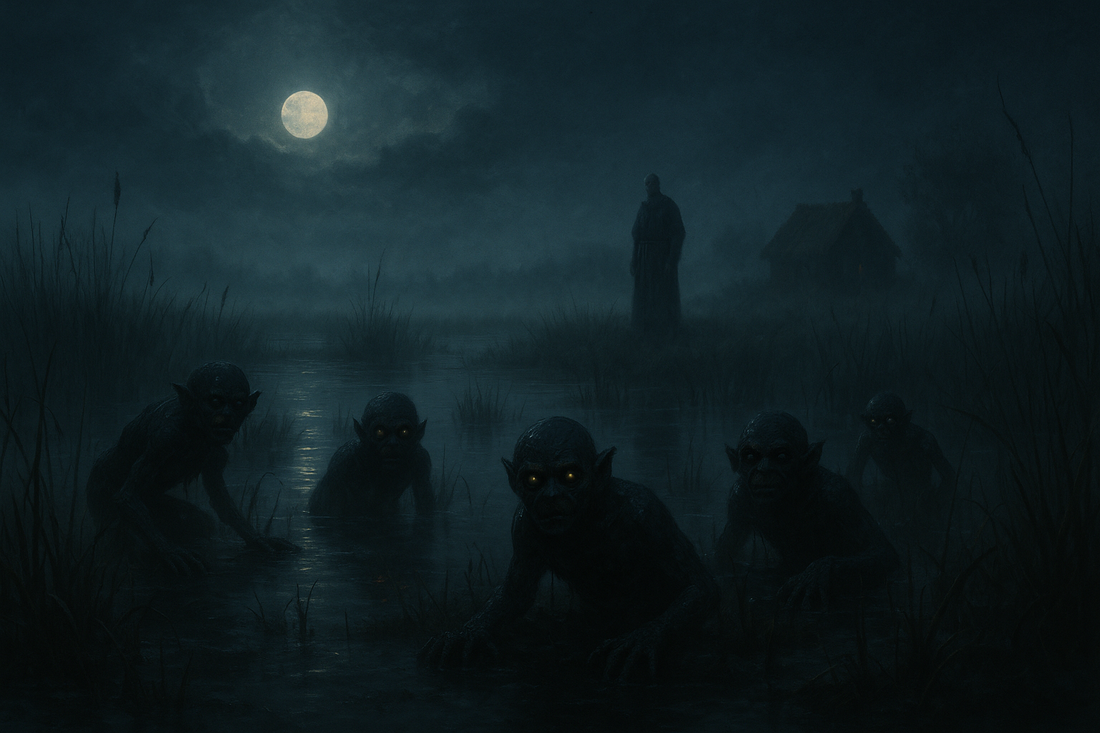
The Goblins of Guthlac’s Fen
Share
Guthlac of Crowland was an Anglo-Saxon warrior who turned his back on battle and wealth around the year 700. At twenty-four he became a monk, and soon after withdrew to the marshes of the Lincolnshire Fens to live as a hermit. There, amid reeds, bogs, and endless fog, he hoped for solitude and communion with God.
But solitude was not what he found. His hagiographer Felix, writing only a few years after his death, records that Guthlac was “assailed day and night by swarms of foul demons.” The Old English poems Guthlac A and B repeat the story in even darker tones, describing creatures that sound far less like angels of hell and far more like goblins: small, black, misshapen things that swarmed, jeered, and clawed at him in the night.

What They Looked Like
Felix speaks of them as “phantoms of the night, foul to behold,” while the poem calls them “black and misshapen monsters” that “swarmed like flies.” They are not grand or terrifying in the way of Satanic princes. They are crooked, ugly, and numerous—shadows given bodies, little horrors with glaring eyes and wide mouths shrieking in the dark. Some versions hint at wings, ragged and bat-like, but most were hunched and clawed, crawling from the reeds or rising out of fogbanks like half-formed shapes.
If later goblins are known for their twisted noses and sharp teeth, their hooked grins and crouching bodies, Guthlac’s tormentors seem to be their ancestors. The scribes didn’t dwell on details of skin or limb, but what slips through paints a clear picture: child-sized figures warped into parodies of men, damp as the swamp they lived in, more animal than angel.
What They Did
The goblins of Guthlac’s fen were busy creatures. They did not drift about like ghosts, but assaulted him with all the energy of a mob. Felix writes that they “tormented him with blows and wounds,” clawing and dragging him across the marsh. In one episode they seized him bodily, lifting him into the air with their crooked wings and hurling him into some desolate place. Their presence was not metaphorical. They were physical.

And they were loud. Guthlac’s biographers describe “wild and horrid cries” that filled the night, laughter that mocked every word of his prayers. The poems add that they tempted him with promises of food and ease, but always with “lying words.” When persuasion failed, they shrieked louder, cackling at his endurance.
They belonged to the marsh itself. They rose from stagnant pools, lurked in fog, hissed out of reed-beds. Guthlac did not bring them there; he had stepped into their world. They were the voices of the fen, its dangers given form—small, twisted, mocking beings that waited for him at every turn.
Goblins, Not Devils
To the monks who wrote the story, they could only be demons. But to our ears, they sound much closer to goblins: earthy, mocking, ugly, tied to place more than theology. They did not negotiate grand bargains or wield cosmic power. They laughed, they clawed, they swarmed like vermin.

And in that laughter we glimpse the oldest face of the goblin in English lore. Not the mischievous imp of fairy tales, nor the comic rogue of modern fantasy, but something darker and smaller: the crooked child of the swamp, jeering from the reeds.
If you'd like to know more about the goblins visit our article A Medieval Battle in the Fens found in our Ancient & Medieval Legends blog. And since goblins and fairies often share crooked roots, step into The Truth About Fairies.